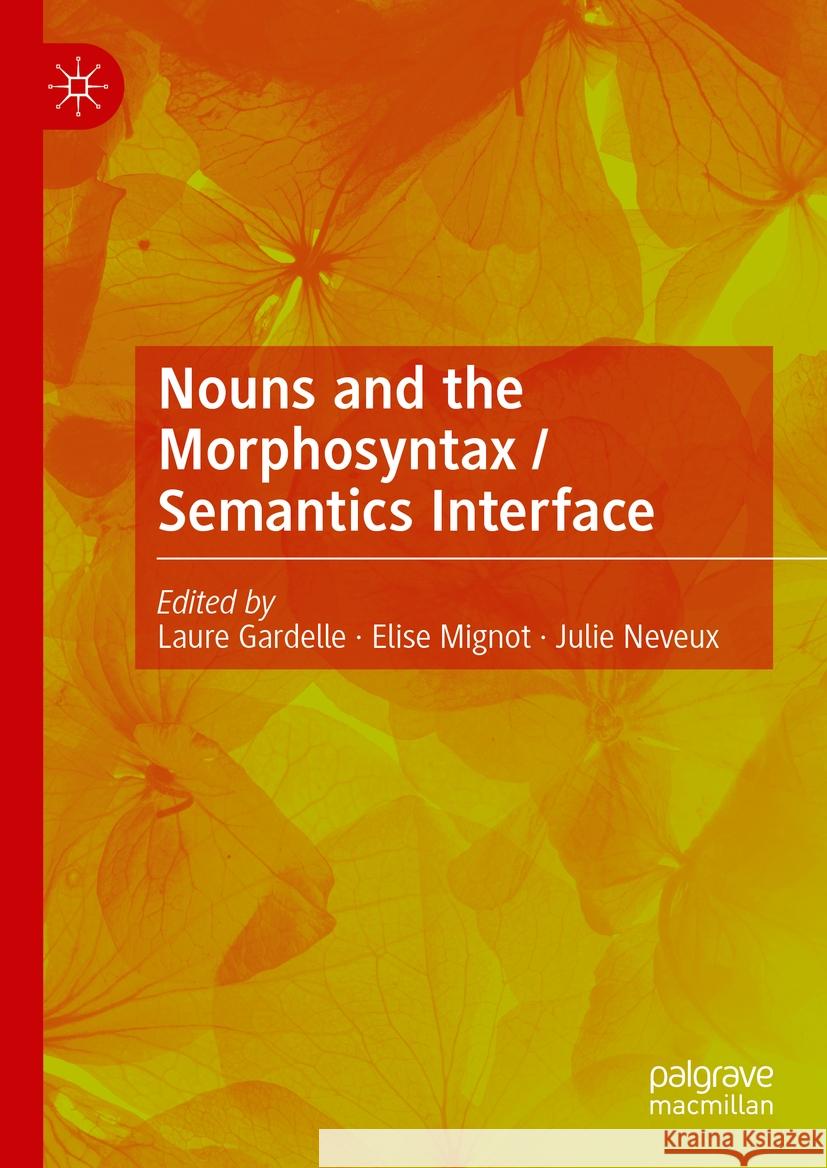Nouns and the Morphosyntax / Semantics Interface » książka



Nouns and the Morphosyntax / Semantics Interface
ISBN-13: 9783031445606 / Angielski
Nouns and the Morphosyntax / Semantics Interface
ISBN-13: 9783031445606 / Angielski
(netto: 514,04 VAT: 5%)
Najniższa cena z 30 dni: 535,99 zł
ok. 20 dni roboczych.
Darmowa dostawa!
Ch. 1 – Laure Gardelle, Elise Mignot & Julie Neveux, “Why the morphosyntax / semantics interface matters for nouns”.-Part 1 – Combining syntax and semantics for new insights into the definition of nouns.-Ch. 2 – Paolo Acquaviva, “Nouns, names, and abstract kinds”.-Ch. 3 – Manon Philippe, “Proper names and the ‘noun’ / ‘name’ categories: pseudo-nouns, real names”.-Ch. 4 – Yayoi Nakamura-Delloye, “The noun class in Japanese: Morphosyntactic and semantic properties”.-Ch. 5 – Peter Lauwers, “Conversion vs coercion in the nominal field: two phenomena at the lexis-grammar interface”.-Part 2 – Interactions between the interpretation of nouns and their syntactic and semantic environment.-Ch. 6 – Wiltrud Mihatsch & Désirée Kleineberg, “The interaction of morphosyntax and semantics in Romance object mass nouns”.-Ch. 7 – Evelien Keizer & Elnora ten Wolde, “Of birds of prey and men of honour: head-classifier constructions in English”.-Ch. 8 – Laure Gardelle, “A swarm of helicopters, the last couple of weeks: a constructional analysis of the syntax/semantics interface for the classification of N1 as ‘collective’ or ‘quantificational’”.-Ch. 9 – Anne Jugnet & Philip Miller, “Polar nouns and Polar Concealed Questions”.-Ch. 10 – Olivia Reneaud-Jensen & Elise Mignot, “God, it’s amazing the junk people will buy! When a construction impacts lexical choices: The case of nouns in concealed exclamations”.-Part 3 - Nouns as syntactic and semantic organisers at phrase and discourse level.-Ch. 11 – Jan Rijkhoff, “Nouns and Iconicity of Distance: when syntactic proximity to the noun mirrors semantic closeness”.-Ch. 12 – John Flowerdew, “Resumptive post-modification as a cohesive feature of signalling nouns”.-Ch. 13 – Marie Turlais, “Influence of the head noun and integration of the dependent in near-compound nominals such as high executive”.-Part 4 - Alignments and mismatches between morphology and lexical or contextual semantics.-Ch. 14 – Laurie Bauer, “The semantics of English nominalizations: How much is usage?”.-Ch. 15 – Julie Neveux, “From productive -ness word-formation to creative suffix -iness: the case of truthiness”.-Ch. 16 – Chris A. Smith, “How is stickage different from sticking? A study of the semantic behaviour of V-age and V-ing nominalisations (on monomorphemic bases)”.-
Laure Gardelle is Professor of English Linguistics and Dean of the doctoral school of languages and literature (ED LLSH) at Grenoble Alpes University, France, and Chair of the French society for English linguistics (ALAES). Her research interests include the morphosyntax/semantics interface in the grammatical categories of gender and number, especially the tension between transparency and the opacification caused by language-internal parameters (such as grammaticisation or morphological attraction).
Elise Mignot is Professor of English Linguistics and Head of the research centre CELISO (Centre de Linguistique en Sorbonne) at Sorbonne University, France. Her research focuses on the morpho-syntax /semantics interface in processes of noun-formation, studied in relation with the cognitive operation of categorization.
Julie Neveux is a Senior lecturer in English Linguistics at Sorbonne University, France, and chair of the French association of English stylistics (SSA). Initially trained in philosophy, she develops a phenomenological approach of language, semantics and style, defining style as a phenomenon whose effects rely on the perceptibility, in discourse, of the speaker’s motivation (embodied cognition).
This edited book seeks to bridge a gap in the existing literature on nouns, by exploring the exact relationship between their formal and semantic characteristics. The introductory chapter offers a thorough state of the art on the morphosyntactic and semantic angles in definitions of nouns, provides evidence of misalignments between morphosyntactic and semantic features, and argues that a multi-criterial angle is in fact inherent in the definition of the class of nouns. The following chapters bring together a representative cross-section of international-level research on the morphosyntax/semantics interface for nouns, covering a wide variety of languages from French-based creoles, German and Japanese to English, French, Italian, Russian and Uzbek. The focus of the volume is to take a special focus on the currently underestimated dynamic interplay between morphosyntax and semantics, at both language and discourse levels. It will be of interest primarily to academics (specialists of nouns, as well as anyone interested in the interplay between morphology, syntax and semantics) and graduate students in areas such as syntax, semantics, morphology, theoretical linguistics and discourse analysis.
Laure Gardelle is Professor of English Linguistics and Dean of the doctoral school of languages and literature (ED LLSH) at Grenoble Alpes University, France, and Chair of the French society for English linguistics (ALAES). Her research interests include the morphosyntax/semantics interface in the grammatical categories of gender and number, especially the tension between transparency and the opacification caused by language-internal parameters (such as grammaticisation or morphological attraction).
Elise Mignot is Professor of English Linguistics and Head of the research centre CELISO (Centre de Linguistique en Sorbonne) at Sorbonne University, France. Her research focuses on the morpho-syntax /semantics interface in processes of noun-formation, studied in relation with the cognitive operation of categorization.
Julie Neveux is a Senior lecturer in English Linguistics at Sorbonne University, France, and chair of the French association of English stylistics (SSA). Initially trained in philosophy, she develops a phenomenological approach of language, semantics and style, defining style as a phenomenon whose effects rely on the perceptibility, in discourse, of the speaker’s motivation (embodied cognition).
1997-2025 DolnySlask.com Agencja Internetowa
KrainaKsiazek.PL - Księgarnia Internetowa









